A vertical garden fence serves as an effective acoustic shield when you combine dense plantings with solid barrier materials. For best results, use evergreen plants with broad leaves like arborvitae or holly, planted in layers against a sturdy, airtight structure at least 8 feet tall. Position your barrier close to the noise source and incorporate climbing vines on trellises for added sound absorption. The integration of water features and varied textures can further enhance your sound-blocking sanctuary.
The Science Behind Acoustic Vegetation Barriers
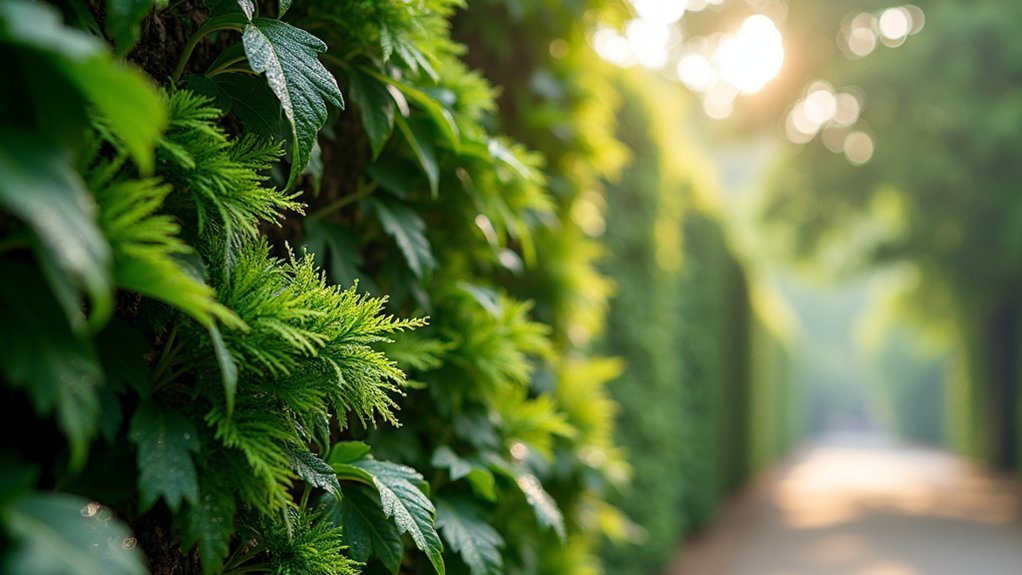
While many homeowners consider fences primarily for privacy, strategically planted vegetation can actually serve as an effective sound barrier for your property. Studies show that dense plantings can reduce noise levels by up to 50% through absorption and deflection of sound waves.
Your vertical garden fence’s effectiveness depends on plant density, height, and type. Evergreen trees work exceptionally well due to their year-round foliage and superior sound blocking capability. Plants with broad leaves and intricate branching patterns provide greater surface area for sound absorption.
For maximum noise reduction, create layered plantings with tall trees as your first defense, complemented by shrubs that fill gaps below.
Beyond acoustic benefits, your vertical garden fence delivers environmental benefits including improved air quality, enhanced biodiversity, and aesthetic value—turning a functional barrier into a living ecosystem that protects your peace and quiet.
Planning Your Vertical Garden Sound Fence
Before breaking ground on your acoustic barrier project, careful planning will determine your vertical garden fence’s effectiveness at blocking unwanted noise. Aim for a height of at least 8 feet to create an effective sound barrier that considerably reduces outdoor noise penetration.
Success with sound barriers starts with strategic planning. Aim for 8-foot heights to effectively block noise infiltration.
Position your structure strategically—either close to the noise source or your living area—to maximize sound-blocking capabilities. Choose dense and heavy materials for the vertical garden fence to achieve a higher STC rating. These soundproofing materials will address noise control problems more effectively than lightweight alternatives.
Ensure your design is completely airtight, as gaps become pathways for sound leakage that undermine your noise issue solutions.
Incorporate sound absorbing materials and noise-attenuating plants within your vertical garden fence to create a multi-layered approach that both blocks and absorbs unwanted sound.
Structural Considerations for Sound-Blocking Garden Walls
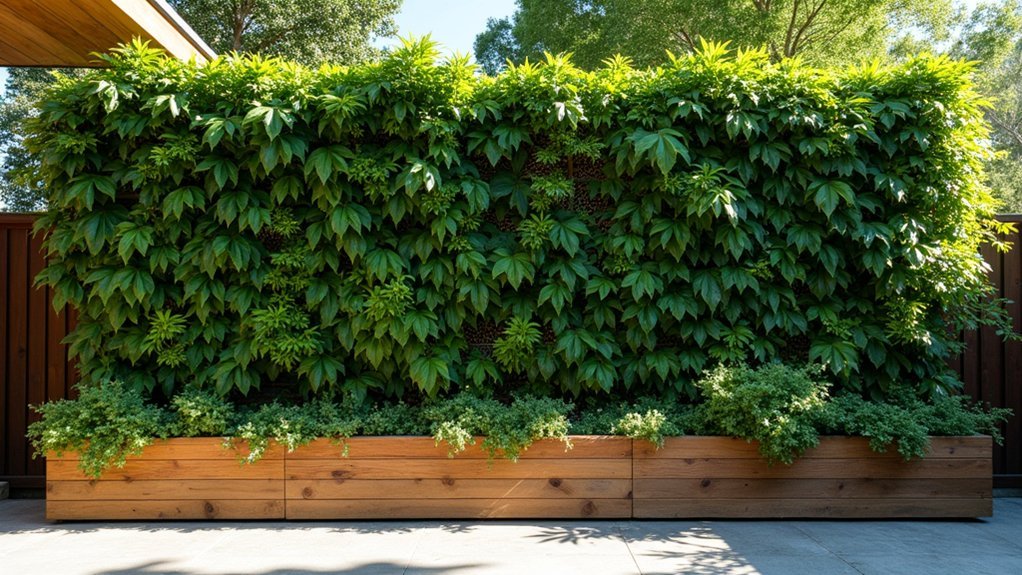
When building your sound-blocking garden wall, you’ll need to calculate the weight-bearing capacity of your foundation to support dense acoustic materials while preventing structural failure.
Your wall’s design must account for wind load resistance, especially for taller 8-foot barriers that face greater pressure during storms.
Consult local building codes to determine proper footing depth and reinforcement requirements, as these specifications vary based on your region’s climate conditions and soil type.
Weight-bearing Capacity Requirements
Every sound-blocking garden wall must be engineered to handle substantial weight loads. When saturated, soil and plants can exceed 100 pounds per square foot, demanding proper structural considerations.
You’ll need sturdy materials like treated wood, steel, or reinforced concrete to withstand the lateral soil pressure created as plants grow.
Ensure your fence has a solid foundation with footings extending 24-36 inches below the frost line in colder regions. This prevents shifting that compromises both sound-blocking and structural integrity.
Don’t overlook drainage—poor water management increases weight and accelerates deterioration.
Even the best-designed walls require regular inspections to maintain their weight-bearing capacity. Check for signs of bowing, cracking, or water damage, especially after extreme weather events.
With proper planning, your acoustic shield will remain structurally sound for years.
Wind Load Resistance
Wind resistance presents another critical engineering challenge for acoustic garden walls. You’ll need to prioritize wind load resistance alongside sound-blocking capabilities to guarantee your structure’s longevity.
The American Society of Civil Engineers recommends designing for at least 30-40 psf in residential areas, though you should verify your local wind speed ratings and building codes.
Your material choices greatly impact both structural integrity and effective sound blocking. Dense options like concrete and brick naturally resist wind while absorbing sound, while reinforced wood requires additional bracing.
Consider incorporating tiebacks or deeper foundations for taller walls that face greater wind exposure.
When planning your garden wall’s height and placement, balance aesthetic desires with engineering necessities.
Remember that proper anchoring techniques can dramatically improve stability during severe weather without compromising the wall’s acoustic performance.
Selecting Plants for Maximum Noise Reduction
The success of your acoustic shield depends largely on selecting the right plants that effectively block and absorb sound waves. Choose dense, evergreen plants like arborvitae or leyland cypress for year-round noise reduction. These varieties create consistent sound barriers regardless of season.
For maximum effectiveness, implement a layered effect by combining taller trees with shorter shrubs to attenuate different sound frequencies. Plants with broad leaves, such as magnolia or holly, outperform smaller-leaved varieties in blocking noise.
Don’t overlook vertical space—climbing plants like ivy or wisteria on trellises increase your fence’s sound-absorbing capacity while adding height to your barrier.
Plant everything closely together to eliminate gaps where sound can penetrate. This strategic grouping transforms individual plants into a cohesive, effective noise barrier that shields your outdoor sanctuary.
Installation Process: Combining Greenery With Soundproofing Materials
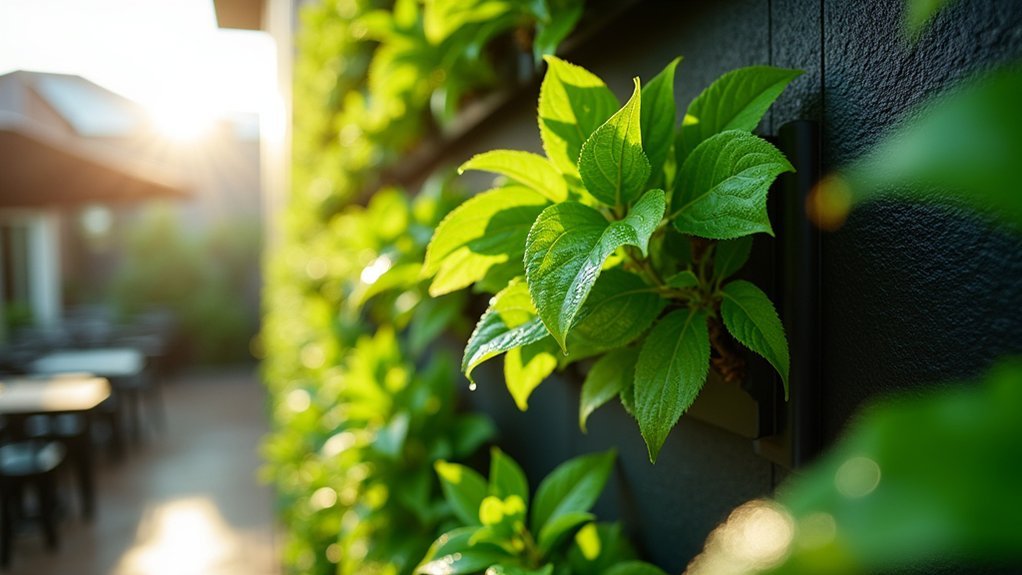
Creating an effective acoustic shield requires strategic layering of both soundproofing materials and vegetation.
Begin your installation process by mounting mass loaded vinyl directly onto your sturdy framework, guaranteeing it’s tightly secured without gaps that would compromise noise reduction. Your framework should stand at least 8 feet tall for peak noise reduction.
Once your soundproofing material is in place, add a plant support system that allows your sound-absorbing plants to thrive without damaging the sound barrier beneath.
Install climbing vines and dense shrubs systematically, spacing them to maximize coverage as they grow. Position larger plants where noise penetration is most problematic.
Remember to maintain greenery through regular pruning and watering. This care guarantees your living sound barrier remains effective while enhancing your outdoor space with natural beauty and improved air quality.
Maintenance Tips for Long-Term Acoustic Performance
While your vertical garden fence initially provides excellent sound reduction, maintaining its acoustic performance requires consistent attention to both structural elements and plant health.
Regularly inspect for gaps or wear in the fence materials to guarantee your soundproofing remains effective. Even small openings can dramatically compromise noise reduction capabilities.
Keep the structure clean by removing debris and vegetation that might trap moisture and cause decay.
Apply protective coatings to wooden components periodically to preserve their structural integrity and sound-blocking properties.
Monitor your vertical garden’s foliage health, as thriving plants enhance sound absorption.
Trim overgrowth promptly to maintain ideal acoustic benefits.
Implement seasonal adjustments by replacing dead plants and reconfiguring arrangements to guarantee your living sound barrier remains both functional and visually appealing year-round.
Enhancing Your Garden Fence With Water Features and Textures
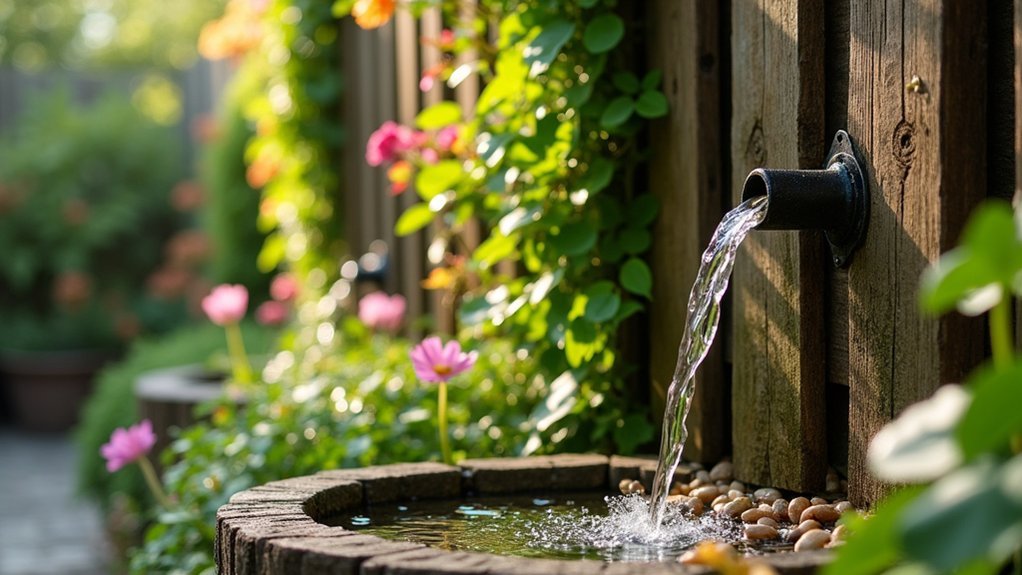
Beyond their visual appeal, water features and textured elements dramatically enhance your acoustic garden fence’s performance while creating a multisensory experience.
By incorporating fountains or small ponds, you’ll mask unwanted noise with soothing sounds while adding visual interest to your outdoor sanctuary.
Flowing water creates a peaceful soundscape, naturally masking neighborhood noise while transforming your garden into a tranquil retreat.
Textured materials like stone or wood lattice improve sound absorption and reduce echo, creating a quieter environment.
Pair these with soft landscaping at the fence base and climbing vines along the structure for maximum sound dampening. Together, these elements break up sound waves and minimize noise transmission from neighboring areas.
- Combine water features with dense plantings to create a natural sound barrier that promotes biodiversity
- Use mulch around your fence base for enhanced echo reduction
- Install trellises for climbing vines that provide both aesthetic appeal and additional acoustic benefits
Frequently Asked Questions
Does Acoustic Fencing Really Work?
Yes, acoustic fencing really works. You’ll experience significant noise reduction if your fence is at least 8 feet tall, built with dense materials like MLV, and constructed without gaps near the noise source.
Can You Soundproof a Garden Fence?
Yes, you can soundproof a garden fence by using dense materials like wood or MLV, building it at least 8 feet high, placing it strategically, adding acoustic panels, and ensuring there are no gaps.
How Much Does Acoustic Fence Cost?
You’ll typically spend $25-$70 per linear foot for acoustic fence materials, plus $10-$30 per foot for installation. A complete project may cost $3,000-$5,000 depending on your fence size and soundproofing needs.
What Is the Best Sound Blocking Fence?
The best sound blocking fence you’ll find is a dense masonry wall (concrete, brick, or stone) that’s at least 8 feet tall, completely airtight, and enhanced with mass-loaded vinyl for maximum noise reduction.
In Summary
Your acoustic garden fence offers the perfect blend of tranquility and beauty for your outdoor space. You’ll enjoy significant noise reduction while creating a vibrant green sanctuary. Remember to maintain your plants regularly and adjust your design seasonally for ideal sound-blocking performance. With thoughtful planning and proper care, you’ve created not just a boundary, but a living sound barrier that enhances your garden’s atmosphere year-round.

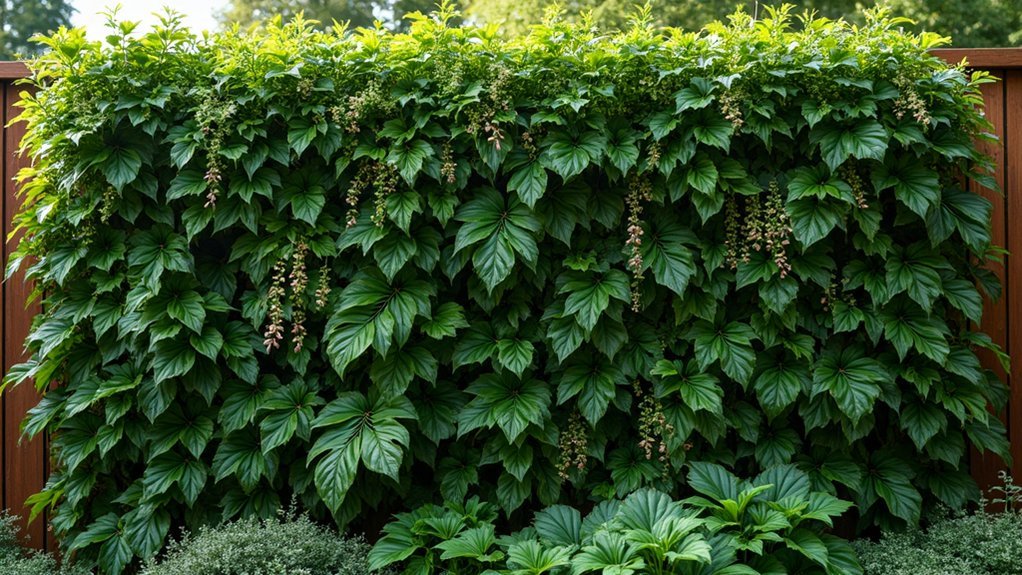



Leave a Reply